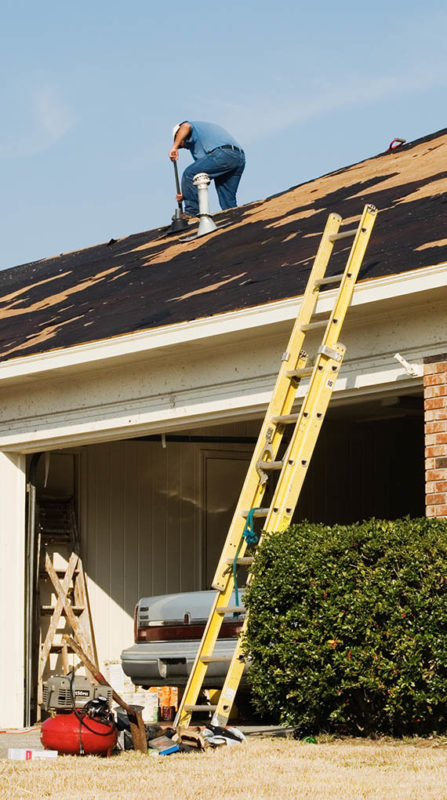STRENGTHEN YOUR HOME AND SAVE MONEY ON YOUR HOMEOWNER'S INSURANCE
For many of us, buying and owning a home is one of the most important investments we make in our lives. When we make this investment, we expect our homes will protect us and serve as a safe haven from hurricanes. To better protect ourselves and our homes when a hurricane hits, we must also invest in building standards and techniques that will strengthen our homes and communities against the catastrophic damage that hurricanes inflict.
HOW DO YOU KNOW IF YOUR HOME IS HURRICANE RESISTANT?
You can start with a Wind Mitigation inspection. The inspection will identify what wind mitigating attributes are present and what you can do to harden your home against violent wind storms and hurricanes.
HOW DO YOU KNOW IF YOUR HOME IS HURRICANE RESISTANT?
Before you can improve your home’s ability to withstand a hurricane, you need to know how hurricane resistant it is today. The inspection will be conducted by a qualified wind inspector trained in wind-resistant building techniques. The inspector will explain what wind mitigating attributes are present and what improvements can be made to strengthen your home against hurricanes and what insurance discounts are available to you if improvements are made. Homes that are strengthened with hurricane-resistant attributes are less likely to suffer serious damage in a hurricane. Homeowners who invest in strengthening their homes will be entitled to a range of discounts on their homeowners insurance premium, depending on what and how many of the recommended improvements are made.
WHAT KIND OF IMPROVEMENTS CAN BE MADE TO STRENGTHEN MY HOME AGAINST HURRICANE DAMAGE?
1. IMPROVING THE STRENGTH OF YOUR ROOF DECK ATTACHMENT.
For instance, if your roof is made of shingles nailed to plywood sheets, the wind inspection may reveal that the plywood sheets are not adequately nailed to your roof trusses, and that more nails and/or longer nails need to be added to prevent the plywood from being blown off during a hurricane.2. CREATING A SECONDARY WATER BARRIER TO PREVENT WATER INTRUSION.
There are products that cover and seal the joints between the plywood sheets on your roof. This will reduce leakage if your shingles are blown off.3. IMPROVING THE SURVIVABILITY OF YOUR ROOF COVERING.
Upgrading to stronger and thicker hurricane-resistant roof shingles, attached with properly sized and applied roofing nails, will reduce the chance of your roof shingles blowing off during a hurricane.4. BRACING GABLE-ENDS IN YOUR ROOF FRAMING.
This is usually done in your attic to lessen the chances that your roof will collapse under hurricane wind loads.5. REINFORCING ROOF-TO-WALL CONNECTIONS.
For example, installing metal tie-down straps that attach roof rafters to wall studs to decrease the chances that all or part of your roof will lift up from your house during a hurricane.6. UPGRADING EXTERIOR WALL-OPENING PROTECTIONS.
Installing hurricane-rated window shutters or other impacted rated materials.7. UPGRADING EXTERIOR DOORS.
For example, replacing a standard garage door with a hurricane-rated garage door. By law, all companies offering homeowners insurance in Florida must provide discounts to policyholders who invest in products and improvements proven to defend a home against hurricane damage. Contact your insurance company or your agent to find out what discounts are available to you after strengthening your home.
5-STAR REVIEWS
ExcellentBased on 7 reviews Trustindex verifies that the original source of the review is Google.
Trustindex verifies that the original source of the review is Google. John Shulthiess2023-12-27Excellent company with excellent people. We had R.J. Lipton Engineering do a wind mitigation review of our home at the framing stage of construction that we were constructing as owner-builders. The home is a fairly large home and with COVID, supply shortages, skyrocketing costs, labor shortages etc. the home took 2+ears until the certificate of occupancy was obtained (January 2023). In November 2023 the Leon County Property Appraiser updated all information for this property. At that point all the information needed by R. J. Lipton Engineering to complete the wind mitigation report was available. I asked that Ron and Lee not be concerned with getting the report to me immediately as I did not need the report for insurance as it was new construction. They insisted that they get the report to me immediately and in fact I received the wind mitigation report shortly thereafter. Lee even included pictures that were not used in the report. We very much respect Ron and Lee for being so patient with us and completing there work 3+ years later as they said they would throughout the building processTrustindex verifies that the original source of the review is Google.
John Shulthiess2023-12-27Excellent company with excellent people. We had R.J. Lipton Engineering do a wind mitigation review of our home at the framing stage of construction that we were constructing as owner-builders. The home is a fairly large home and with COVID, supply shortages, skyrocketing costs, labor shortages etc. the home took 2+ears until the certificate of occupancy was obtained (January 2023). In November 2023 the Leon County Property Appraiser updated all information for this property. At that point all the information needed by R. J. Lipton Engineering to complete the wind mitigation report was available. I asked that Ron and Lee not be concerned with getting the report to me immediately as I did not need the report for insurance as it was new construction. They insisted that they get the report to me immediately and in fact I received the wind mitigation report shortly thereafter. Lee even included pictures that were not used in the report. We very much respect Ron and Lee for being so patient with us and completing there work 3+ years later as they said they would throughout the building processTrustindex verifies that the original source of the review is Google. Daniel Krick2022-05-26I had the 4 point inspection and had a very Professional and responsive inspection. My inspection was easy to schedule. My inspector Lee was very knowledgeable on time and was able to answer all questions. They are very reasonably priced. The finished report was very professional and just what I needed. I want to highly recommend R.J. Lipton Engineering.Trustindex verifies that the original source of the review is Google.
Daniel Krick2022-05-26I had the 4 point inspection and had a very Professional and responsive inspection. My inspection was easy to schedule. My inspector Lee was very knowledgeable on time and was able to answer all questions. They are very reasonably priced. The finished report was very professional and just what I needed. I want to highly recommend R.J. Lipton Engineering.Trustindex verifies that the original source of the review is Google. Jeff Naylor2022-05-20As a lifelong Tallahasseean and top 1% real estate agent in the N FL area, I highly recommend Mr. Lipton based on both personal and professional experience. Ron is very responsive, prompt and punctual. All homeowners that I've recommended to Mr. Lipton provided feedback that they were very happy with his services.Trustindex verifies that the original source of the review is Google.
Jeff Naylor2022-05-20As a lifelong Tallahasseean and top 1% real estate agent in the N FL area, I highly recommend Mr. Lipton based on both personal and professional experience. Ron is very responsive, prompt and punctual. All homeowners that I've recommended to Mr. Lipton provided feedback that they were very happy with his services.Trustindex verifies that the original source of the review is Google. Jessica Parcher2021-11-16Ron was AWESOME! I needed a wind mitigation inspection super last minute and he was able to get me in quickly. He even went above and beyond when my realtor had me ask him to check something well after business hours. He dropped everything to help me. Professional. Responsive. Timely. I highly recommend Rj Lipton!Trustindex verifies that the original source of the review is Google.
Jessica Parcher2021-11-16Ron was AWESOME! I needed a wind mitigation inspection super last minute and he was able to get me in quickly. He even went above and beyond when my realtor had me ask him to check something well after business hours. He dropped everything to help me. Professional. Responsive. Timely. I highly recommend Rj Lipton!Trustindex verifies that the original source of the review is Google. Clay Spaulding2021-10-28I work with a large management company and need various inspections done for my clients on a regular basis and Ron Lipton goes above and beyond to get inspections completed even with short notice. The inspection reports are extremely detailed and informative. I would highly recommend using them!Trustindex verifies that the original source of the review is Google.
Clay Spaulding2021-10-28I work with a large management company and need various inspections done for my clients on a regular basis and Ron Lipton goes above and beyond to get inspections completed even with short notice. The inspection reports are extremely detailed and informative. I would highly recommend using them!Trustindex verifies that the original source of the review is Google. ryan kasak2020-04-20This guy is awesome, I have been using him for my customer home inspections for 2 years now and they have always been perfect. If you need somebody for home inspections definitely use this guy!Trustindex verifies that the original source of the review is Google.
ryan kasak2020-04-20This guy is awesome, I have been using him for my customer home inspections for 2 years now and they have always been perfect. If you need somebody for home inspections definitely use this guy!Trustindex verifies that the original source of the review is Google. Rob Coleman2018-03-28Mr Lipton was professional, thorough, courteous, and I couldn't be happier with his inspection. He was running a few minutes late and called to let me know he was delayed. That said, he arrived within 10 minutes of the scheduled time. He protected my home, placing a mat beneath his ladder to ensure that there was no possibility of scarring the hardwood. He very patiently and completely explained what he had found in his wind mitigation inspection. I considered his fee very reasonable, especially given the thoroughness of his inspection. I would recommend RJ Lipton Engineering to anyone.
Rob Coleman2018-03-28Mr Lipton was professional, thorough, courteous, and I couldn't be happier with his inspection. He was running a few minutes late and called to let me know he was delayed. That said, he arrived within 10 minutes of the scheduled time. He protected my home, placing a mat beneath his ladder to ensure that there was no possibility of scarring the hardwood. He very patiently and completely explained what he had found in his wind mitigation inspection. I considered his fee very reasonable, especially given the thoroughness of his inspection. I would recommend RJ Lipton Engineering to anyone.
